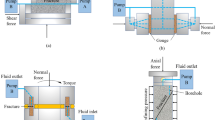Abstract
The paper applies the observation cycle to rock fracturing processes. Specifically, it repeats the observation cycle by going from the large (field) scale to increasingly detailed laboratory scales. With this, it is possible to determine that what appear to be tensile or shear fractures on the large scale are produced through a combination of tensile and shear mechanisms on the smaller scale. This involves observations with a variety of techniques that are briefly described. What is also emphasized is that observation has to go hand in hand with abstraction, i.e., modeling to help understand the observed phenomena. The paper, therefore, makes two contributions—a better understanding of rock fracturing processes and showing the importance of the observation cycle in a scientific process.










































Similar content being viewed by others
Abbreviations
- εv :
-
Volumetric strain
- ε1 :
-
Major principal strain
- ε3 :
-
Minor principal strain
- γ:
-
Shear strain
- σn :
-
Normal stress
- τ:
-
Shear stress
References
Bruhn RW (1969) The strength and deformability of a model rock with one set of joints perpendicular to a principal axis. MSc thesis, MIT
Cloos E (1955) Experimental analysis of fracture patterns. Bull Geol Soc Am 66:241–256
Dershowitz W (1985) Rock joint systems. PhD dissertation, Massachusetts Institute of Technology
Doe T, Mc Laren R, Dershowitz W (2014) Discrete fracture network simulations of enhanced geothermal systems. In: Proceedings of the thirty-ninth workshop on geothermal reservoir engineering, Stanford University
Einstein HH (2008) Reducing uncertainty through updating—from experiments to the observational method. In: Proceedings of the 11th ISRM Congress, 9–13 July, Lisbon, Portugal
Ivanova VM, Sousa R, Murrihy B, Einstein HH (2014) Mathematical algorithm development and parametric studies with the GEOFRAC three-dimensional stochastic model of natural rock fracture systems. Comput Geosci 67:100–109
Jennings JE (1970) A mathematical theory for the calculation of the stability of slopes in open cast mines. In: Proceedings of the Symp on Planning Open Pit Mines, Johannesburg, 1970, pp 87–102
Kulander BR, Barton CC, Dean SL (1979) The application of fractography to core and outcrop fracture. US DOE Report METCSP-79/3
Lajtai EZ (1969) Strength of discontinuities in rock in direct shear. Géotechnique 19:218–233
Li BQ (2019) Microseismic and real-time imaging of fractures and microfractures in Barre granite and Opalinus clayshale. PhD dissertation, Massachusetts Institute of Technology
Li BQ, Einstein HH (2019) Direct and microseismic observations of hydraulic fracturing in Barre granite and Opalinus clayshale. J Geophys Res Solid Earth 124:11900–11916
Morgan SP, Johnson CA, Einstein HH (2013) Cracking processes in Barre granite: fracture process zones and crack coalescence. Int J Frac 180(2):177–204
Paterson M (1958) Experimental deformation and faulting of Wombeyan marble. Bull Geol Soc Am 69:465–476
Peck RB (1969) Advantages and limitations of the observational method. Géotechnique 19(2):171–187
Riedel W (1929) Zur mechanik geologischer brucherscheinungen. Zentralblatt für Mineralogie Abt B 354–368
Terzaghi K (1961) Past and future of applied soil mechanics. Journal BSCE 68:110–139
Wong LNY, Einstein HH (2009a) Crack coalescence in molded gypsum and Carrara marble: Part 1. Macroscopic observations and interpretation. Rock Mech Rock Eng 42(3):475–511
Wong LNY, Einstein HH (2009b) Crack coalescence in molded gypsum and Carrara marble: Part 2. Macroscopic observations and interpretation. Rock Mech Rock Eng 42(3):513–545
Woodworth JB (1896) On the fracture systems of joints—with some remarks on great fractures. In: Proceedings Boston Society of Natural History
Acknowledgements
The research was conducted by many students, postdoctoral fellows and involved collaboration with colleagues. Their names are shown in Fig. 1. The author would also like to thank the organizers of the 2019 ARMA Symposium and MTS for the invitation to present this keynote lecture.
Funding
The research underlying the presented work was funded by a variety of sponsors over the past 2 decades. The author received an honorarium by MTS to present the keynote lecture at the 2019 ARMA Symposium.
Author information
Authors and Affiliations
Corresponding author
Ethics declarations
Conflict of interest
None.
Additional information
Publisher's Note
Springer Nature remains neutral with regard to jurisdictional claims in published maps and institutional affiliations.
Rights and permissions
About this article
Cite this article
Einstein, H.H. Fractures: Tension and Shear. Rock Mech Rock Eng 54, 3389–3408 (2021). https://doi.org/10.1007/s00603-020-02243-8
Received:
Accepted:
Published:
Issue Date:
DOI: https://doi.org/10.1007/s00603-020-02243-8




